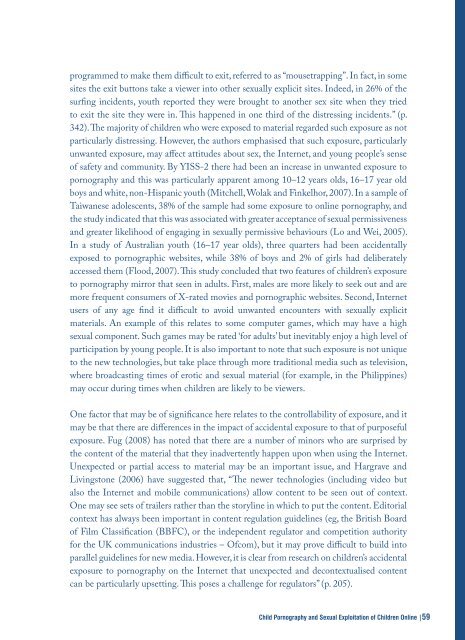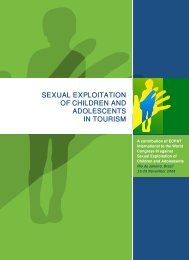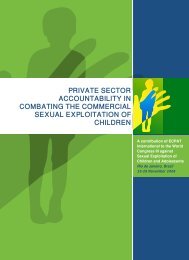to download the document in PDF format - Child Centre: Expert ...
to download the document in PDF format - Child Centre: Expert ...
to download the document in PDF format - Child Centre: Expert ...
Create successful ePaper yourself
Turn your PDF publications into a flip-book with our unique Google optimized e-Paper software.
programmed <strong>to</strong> make <strong>the</strong>m difficult <strong>to</strong> exit, referred <strong>to</strong> as “mousetrapp<strong>in</strong>g”. In fact, <strong>in</strong> somesites <strong>the</strong> exit but<strong>to</strong>ns take a viewer <strong>in</strong><strong>to</strong> o<strong>the</strong>r sexually explicit sites. Indeed, <strong>in</strong> 26% of <strong>the</strong>surf<strong>in</strong>g <strong>in</strong>cidents, youth reported <strong>the</strong>y were brought <strong>to</strong> ano<strong>the</strong>r sex site when <strong>the</strong>y tried<strong>to</strong> exit <strong>the</strong> site <strong>the</strong>y were <strong>in</strong>. This happened <strong>in</strong> one third of <strong>the</strong> distress<strong>in</strong>g <strong>in</strong>cidents.” (p.342). The majority of children who were exposed <strong>to</strong> material regarded such exposure as notparticularly distress<strong>in</strong>g. However, <strong>the</strong> authors emphasised that such exposure, particularlyunwanted exposure, may affect attitudes about sex, <strong>the</strong> Internet, and young people’s senseof safety and community. By YISS-2 <strong>the</strong>re had been an <strong>in</strong>crease <strong>in</strong> unwanted exposure <strong>to</strong>pornography and this was particularly apparent among 10–12 years olds, 16–17 year oldboys and white, non-Hispanic youth (Mitchell, Wolak and F<strong>in</strong>kelhor, 2007). In a sample ofTaiwanese adolescents, 38% of <strong>the</strong> sample had some exposure <strong>to</strong> onl<strong>in</strong>e pornography, and<strong>the</strong> study <strong>in</strong>dicated that this was associated with greater acceptance of sexual permissivenessand greater likelihood of engag<strong>in</strong>g <strong>in</strong> sexually permissive behaviours (Lo and Wei, 2005).In a study of Australian youth (16–17 year olds), three quarters had been accidentallyexposed <strong>to</strong> pornographic websites, while 38% of boys and 2% of girls had deliberatelyaccessed <strong>the</strong>m (Flood, 2007). This study concluded that two features of children’s exposure<strong>to</strong> pornography mirror that seen <strong>in</strong> adults. First, males are more likely <strong>to</strong> seek out and aremore frequent consumers of X-rated movies and pornographic websites. Second, Internetusers of any age f<strong>in</strong>d it difficult <strong>to</strong> avoid unwanted encounters with sexually explicitmaterials. An example of this relates <strong>to</strong> some computer games, which may have a highsexual component. Such games may be rated ‘for adults’ but <strong>in</strong>evitably enjoy a high level ofparticipation by young people. It is also important <strong>to</strong> note that such exposure is not unique<strong>to</strong> <strong>the</strong> new technologies, but take place through more traditional media such as television,where broadcast<strong>in</strong>g times of erotic and sexual material (for example, <strong>in</strong> <strong>the</strong> Philipp<strong>in</strong>es)may occur dur<strong>in</strong>g times when children are likely <strong>to</strong> be viewers.One fac<strong>to</strong>r that may be of significance here relates <strong>to</strong> <strong>the</strong> controllability of exposure, and itmay be that <strong>the</strong>re are differences <strong>in</strong> <strong>the</strong> impact of accidental exposure <strong>to</strong> that of purposefulexposure. Fug (2008) has noted that <strong>the</strong>re are a number of m<strong>in</strong>ors who are surprised by<strong>the</strong> content of <strong>the</strong> material that <strong>the</strong>y <strong>in</strong>advertently happen upon when us<strong>in</strong>g <strong>the</strong> Internet.Unexpected or partial access <strong>to</strong> material may be an important issue, and Hargrave andLiv<strong>in</strong>gs<strong>to</strong>ne (2006) have suggested that, “The newer technologies (<strong>in</strong>clud<strong>in</strong>g video butalso <strong>the</strong> Internet and mobile communications) allow content <strong>to</strong> be seen out of context.One may see sets of trailers ra<strong>the</strong>r than <strong>the</strong> s<strong>to</strong>ryl<strong>in</strong>e <strong>in</strong> which <strong>to</strong> put <strong>the</strong> content. Edi<strong>to</strong>rialcontext has always been important <strong>in</strong> content regulation guidel<strong>in</strong>es (eg, <strong>the</strong> British Boardof Film Classification (BBFC), or <strong>the</strong> <strong>in</strong>dependent regula<strong>to</strong>r and competition authorityfor <strong>the</strong> UK communications <strong>in</strong>dustries – Ofcom), but it may prove difficult <strong>to</strong> build <strong>in</strong><strong>to</strong>parallel guidel<strong>in</strong>es for new media. However, it is clear from research on children’s accidentalexposure <strong>to</strong> pornography on <strong>the</strong> Internet that unexpected and decontextualised contentcan be particularly upsett<strong>in</strong>g. This poses a challenge for regula<strong>to</strong>rs” (p. 205).<strong>Child</strong> Pornography and Sexual Exploitation of <strong>Child</strong>ren Onl<strong>in</strong>e |59




